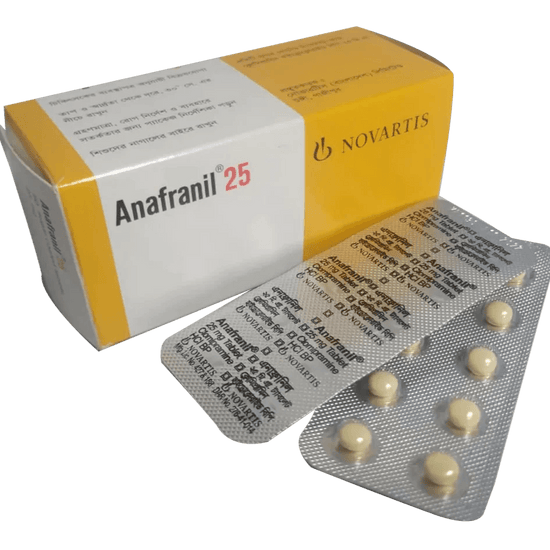What Is Anafranil, Its Uses, and Side Effects
What is Anafranil (Clomipramine)?
What is Anafranil (Clomipramine)?
Anafranil, also known as Clomipramine, is a medication that has been a vital part of mental health treatment for decades. Developed in the 1960s, this tricyclic antidepressant (TCA) was initially designed to address severe cases of depression. However, its unique properties and versatility soon made it a go-to treatment for individuals struggling with obsessive-compulsive disorder (OCD), anxious depression, and certain types of chronic pain conditions.
Tricyclic antidepressants: Understanding TCA
To grasp the significance of Anafranil, it’s essential to understand the broader category it belongs to: tricyclic antidepressants. First discovered in the late 1950s, TCAs represent an older generation of medications that have been a cornerstone in the treatment of depression and associated conditions. These medications rely on the ability to restore normal levels of neurotransmitters such as serotonin, norepinephrine, and acetylcholine. Clomipramine specifically interacts with serotonin, norepinephrine, and other neurotransmitters to promote balanced neurological responses.
Anafranil in Mental Health Treatment
Anafranil started gaining recognition as an effective treatment for OCD, which results from excessively high levels of serotonin and serotonin receptor activity within the brain. It was then discovered that unique effects of Clomipramine were beneficial in not only treating depression but can also control thoughts in an individual’s mind, thus effectively mitigating the behavior signs of these particular behaviors like intense fear & anxiety surrounding everyday events. Historically utilized and effective for chronic pain conditions such as fibromyalgia and neuropathic pain syndrome treatment, these properties often work alongside standard medical care like psychotherapy.
Anafranil Administration and Therapy
Anafranil (clomipramine) affects patients differently, and thus the daily dosage is typically advised based on individual requirements for effective results, especially for OCD. Generally, clomipramine is started at about 40 milligrams daily for moderate stress but can range up to 200 milligrams, with many patients beginning to notice efficacy after three weeks. Proper management by healthcare providers is crucial to avoid exacerbation or adverse effects from interactions with other medications or therapies.
Safety: Possible Anafranil Risks and Side Effects
While Anafranil offers substantial therapeutic benefits for mental health conditions, there are various risks due to potential interactions with other medications. Common adverse reactions reported include appetite loss, sedation, nausea, and dizziness, particularly at higher doses. Close medical supervision is necessary to adjust dosages as needed to mitigate these risks.
Key Points for Anafranil Treatment
- Tricyclic antidepressant that helps to recover brain chemicals for balanced functioning.
- Initially used for severe depression before recognition as effective for OCD.
- Working alongside therapy sessions improves individual responses, with careful monitoring of side effects by medical providers.
What to Expect When Taking Anafranil
- Mental Health Benefits: Relief from severe symptoms in depressive and anxiety disorders.
- Mood Stabilization: Enhancement of neurotransmitter balance leading to improved mental health.
- Withdrawal Symptoms: Importance of avoiding abrupt cessation to prevent withdrawal side effects.
Relevant Terms and Concepts
Understanding the terms associated with Anafranil is crucial: Anafranil, Anafranil for OCD, Anafranil clomipramine, Anafranil tricyclic antidepressant, Clomipramine dosing and side effects.

Overview and Historical Context
Overview and Historical Context of Anafranil
Anafranil’s origins date back to the 1960s when clomipramine, its primary active ingredient, was synthesized in a European pharmaceutical laboratory. It gained FDA approval for marketing in the United States as the first medication specifically for the treatment of OCD, influencing mental health practices profoundly.
Case Studies and Examples of Anafranil Effectiveness
Anafranil has made a significant difference in the lives of many patients struggling with OCD and anxiety-related conditions. Case studies highlight the compound's effectiveness when combined with therapies and address common challenges like withdrawal through gradual dosage adjustment and holistic lifestyle changes.
Key Parts of Anafranil
Anafranil, a TCA and SSRI combined medication, features a unique structure that impacts neurotransmitter functionality, crucial in treating OCD and related symptoms.
For individuals dealing with anxiety and ADHD, GoblinX offers tools to supplement therapeutic efforts effectively. Resources available in the GoblinX mobile app can help enhance mental wellness and offer strategies for coping with medication adjustments and symptoms.
For more information, visit the GoblinX website for resources on managing anxiety and ADHD supported by clinically-backed strategies.
Important Sources
| Clomipramine (Anafranil): Uses & Side Effects - Cleveland Clinic | Clomipramine is an antidepressant medication that treats obsessive-compulsive disorder (OCD). It belongs to a group of medications called tricyclic antidepressants (TCAs). |
| Anafranil Oral: Uses, Side Effects, Interactions | |
| Clomipramine (Anafranil): Uses, Side Effects, Warnings & More | Find information about clomipramine (Anafranil) usage and dosing, side effects and popular alternatives. |
| Clomipramine (Anafranil) - Uses, Side Effects, and More - WebMD | Find patient medical information for Clomipramine (Anafranil) including its uses, side effects and safety. |
| Clomipramine - Wikipedia | Anafranil is a tricyclic antidepressant used in the treatment of various conditions, most notably obsessive–compulsive disorder (OCD). |
| Clomipramine (oral route) - Mayo Clinic | Description: Clomipramine is used to treat obsessive-compulsive disorder (OCD). |
| Anafranil (clomipramine) dosing, indications |